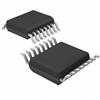Features: `Fast Throughput Rate: 1 MSPS
`Specified for AVDD of 2.7 V to 5.25 V
`Low Power:
`6.0 mW Max at 1 MSPS with 3 V Supply
`13.5 mW Max at 1 MSPS with 5 V Supply
`8 (Single-Ended) Inputs with Sequencer
`Wide Input Bandwidth:
`AD7928, 70 dB Min SINAD at 50 kHz Input Frequency
`Flexible Power/Serial Clock Speed Management
`No Pipeline Delays
`High Speed Serial Interface SPI®/QSPI™/
`MICROWIRE™/DSP Compatible
`Shutdown Mode: 0.5 A Max
`20-Lead TSSOP PackagePinout
 Specifications
Specifications
| Resolution (Bits) |
12bit |
| T-Put Rate |
1MSPS |
| # Chan |
8 |
| Supply V |
Single(+3),Single(+3.3),Single(+5) |
| Pwr Diss |
13.5mW |
| Interface |
Ser,SPI |
| Ain Range |
Uni (Vref),Uni (Vref) x 2 |
| SNR (dB) |
70dB |
| Pkg Type |
SOP |
AVDD to AGND........................................................... 0.3 V to +7 V
VDRIVE to AGND........................................... 0.3 V to AVDD + 0.3 V
Analog Input Voltage to AGND..................... 0.3 V to AVDD + 0.3 V
Digital Input Voltage to AGND................................... 0.3 V to +7 V
Digital Output Voltage to AGND....................0.3 V to AVDD + 0.3 V
REFIN to AGND............................................ 0.3 V to AVDD + 0.3 V
Input Current to Any Pin Except Supplies2......................... ±10 mA
Operating Temperature Range
Commercial (B Version)...................................... 40°C to +85°C
Storage Temperature Range............................65°C to +150°C
Junction Temperature.......................................................... 150°C
TSSOP Package, Power Dissipation.....................................450 mW
qJA Thermal Impedance......................................143°C/W (TSSOP)
qJC Thermal Impedance....................................... 45°C/W (TSSOP)
Lead Temperature, Soldering
Vapor Phase (60 sec)...........................................................215°C
Infrared (15 sec).................................................................. 220°C
ESD........................................................................................... 2 kV
NOTES
1 Stresses above those listed under Absolute Maximum Ratings may cause permanent damage to the device. This is a stress rating only and functional operation of the device at these or any other conditions above those listed in the operational sections of this specification is not implied. Exposure to absolute maximum rating conditions for extended periods may affect device reliability.
2 Transient currents of up to 100 mA will not cause SCR latch-up.
DescriptionThe AD7908/AD7918/AD7928 are, respectively, 8-bit, 10-bit, and 12-bit, high speed, low power, 8-channel, successive approximation ADCs. The parts operate from a single 2.7 V to 5.25 V power supply and feature throughput rates up to 1 MSPS. The parts contain a low noise, wide bandwidth trackand- hold amplifier that can handle input frequencies in excess of 8 MHz.
The conversion process and data acquisition are controlled usingCS and the serial clock signal, allowing the device to easily interface with microprocessors or DSPs. The input signal is sampled on the falling edge ofCS and conversion is also initiated at this point. There are no pipeline delays associated with the part. The AD7908/AD7918/AD7928 use advanced design techniques to achieve very low power dissipation at maximum throughput rates. At maximum throughput rates, the AD7908/AD7918/AD7928 consume 2 mA maximum with 3 V supplies; with 5 V supplies, the current consumption is 2.7 mA maximum. Through the configuration of the Control Register, the analog input range for the part can be selected as 0 V to REFIN or 0 V to 2 REFIN, with either straight binary or twos complement output coding.
The AD7908/AD7918/AD7928 each feature eight single-ended analog inputs with a channel sequencer to allow a preprogrammed selection of channels to be converted sequentially. The conversion time for the AD7908/AD7918/AD7928 is determined by the SCLK frequency, which is also used as the master clock to control the conversion.

 AD7928 Data Sheet
AD7928 Data Sheet








